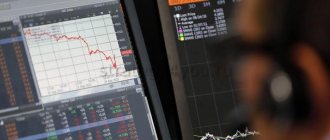Security capitalization is the market price of one outstanding security - stocks, bonds, futures and others. The price is set by trading participants on the stock exchange. If shares at some point were trading at an average of 270 rubles per share, this will be the capitalization of the security at a particular point in time.
If we know how much one security currently costs on the stock market and how many such securities have been issued, then we can easily calculate the value of the final asset. This way we will get, for example, the market capitalization of a company, that is, its value calculated based on the total value of all its shares. To do this, you need to multiply the market price of one share by the number of shares.
Let's say a company has issued 100,000 shares, and they are now trading at a price of 1,000 rubles each, then the company's market capitalization will be 100 million rubles. But then the news came that the directors of the joint-stock company were suspected of fraud. He himself went to London and does not comment on the situation. The next day, the owners of the shares began to urgently get rid of them, and the price of the securities on the market dropped to 500 rubles per share. This means that the company’s capitalization has decreased by half, and now the company is worth 50 million rubles.
In other words, a company's market capitalization is the amount it would cost to acquire the entire company at the current share price.
By adding up the market value of all securities traded on any market, we get the market capitalization of that stock market.
Market capitalization is one of the indicators of a company's value.
It allows you to find out approximately how much a given company is worth on the stock market. Traditionally, market capitalization is also called the cost of capital in the stock market, and it is a basic mathematical calculation. However, it is only one of the guidelines in assessing the value of an enterprise. Let's look at what components make up this characteristic, how it is calculated, and what differences it has from other assessment methods that can be used when selecting specific stocks for investment.
Fact
In addition to market capitalization, there is also capitalization of deposit interest. In this case, the bank adds accrued interest to the deposit every month, six months or a year, or another period established by the agreement.
For example, a depositor deposited 25,000 rubles for 3 years at 10% per annum with annual interest capitalization. This means that in a year the owner of the deposit will have an investment amount of +10% of it, that is, 27,500 rubles. Next year, 10% will be added to the resulting amount; at the end of the year, the contribution will increase: 27,500 + 2,750 = 30,250 rubles. In the third year, the amount received will again be increased by 10%, that is, by 3,025 rubles; as a result, the investor will take 33,275 rubles.
Market capitalization calculation
To calculate capitalization, you need to know the exact number of shares issued by it for the entire time, from its entry into the stock market to the current moment. Now such information is quickly found in specialized publications like Reuters, as well as in financial statements published directly by the company itself. This figure is multiplied by the price at which one share is sold.
Let's say you want to calculate how much the stock market currently values Apple Corporation at. As of March 23, 2018, the company had issued 5,074,010,000 shares at a price of $168.39 each. We multiply the numbers and see that the market capitalization of Apple Corporation is $854,412,543,900.
Rating of the 60 largest exchanges by their capitalization
According to the rating of the Masterforex-V Academy , updated monthly by capitalization of the TOP-60 world stock exchanges, which as of April 1, 2022 amounted to the following figures:
1. New York Stock Exchange – capitalization $23.211 trillion; 2. NASDAQ: No. 2 stock exchange in the world – capitalization $11.218 trillion. 3. Tokyo Stock Exchange – capitalization $5.608 trillion. 4. Shanghai Stock Exchange SSE – $5.013 trillion. 5. Hong Kong Stock Exchange HKE – $4.307 trillion. 6. Euronext exchange (Paris, Amsterdam, Brussels, Lisbon, Dublin) – $4.268 trillion. 7. London Stock Exchange LSE – $3.965 trillion. 8. Shenzhen Stock Exchange SZSE – $3.355 trillion. 9. Toronto Stock Exchange – $2.216 trillion. 10. Bombay Stock Exchange BSE – $2.179 trillion. 11. National Stock Exchange of India - $2.156 trillion. 12. Frankfurt Stock Exchange - $1.867 trillion. 13. Swiss Stock Exchange - $1,603 billion; 14. Korean Stock Exchange - $1,468 billion; 15. OMX Group Nasdaq Nordic Exchange (Vilnius, Iceland, Copenhagen, Riga, Stockholm, Tallinn, Helsinki, Armenian stock exchanges) - $$1.432 trillion. 16. Australian stock exchange ASX - $1.384 trillion. 17. Taiwan TWSE - $$1.041 trillion. 18. Johannesburg Stock Exchange (South Africa) - $0.950 trillion. 19. Sao Paulo Stock Exchange (Brazil) - $820 billion; 20. Madrid Stock Exchange - $0.770 trillion. 21. Singapore Stock Exchange - $0.715 trillion. 22. Moscow Stock Exchange MOEX - $636 billion 23. Saudi Stock Exchange (Tadawul) - $557 billion 24. Stock Exchange of Thailand (SET) - $535 billion 25. Malaysian Exchange (Bursa Malaysia, KLSE) - $409 billion 26. Mexican Stock Exchange (Spanish: Bolsa Mexicana de Valores, BMV) - $399 billion 27. Oslo Stock Exchange (OSE) - $293 billion 28. Philippine Stock Exchange (PSE) - $276 billion 29 Santiago Stock Exchange (Bolsa de Comercio de Santiago) - $254 billion 30. Tel Aviv Stock Exchange (TASE) - $207 billion 31. Istanbul Stock Exchange Borsa Istanbul, BIST) - $165 billion 32. Warsaw Stock Exchange (WSE) - $165 billion 33. Qatar Stock Exchange (QSE) - $156.93 billion 34. Abu Dhabi Securities Exchange - $140.91 billion 35. Stock Exchange Hochiminh Stock Exchange (HOSE) - $128.78 billion 36. Vienna Stock Exchange (Wiener Borse AG, WBAG) - $125.92 billion 37. Irish Stock Exchange (ISE) - $110.47 billion 38. Taipei Stock Exchange of Taiwan (Taipei Exchange) - $103.8 billion 39. New Zealand Exchange - $95.8 billion 40. Dubai Financial Market (DFM) - $95.65 billion 41. Casablanca Stock Exchange (Bourse de Casablanca, ESG) - $58.28 billion 42. Luxembourg Stock Exchange (LuxSE) - $49.41 billion 43. Egyptian Exchange (EGX) - $47.20 billion 44. Buenos Aires Stock Exchange (Spanish) Bolsa de Comercio de Buenos Aires) - $40.83 billion 45. Kazakhstan Stock Exchange (KASE) - $37.21 billion 46. Tehran Stock Exchange (TSE) - $33.83 billion 47. Nigerian Stock Exchange (NSE) - $31.83 billion 48 Budapest Stock Exchange (BSE) - $30.69 billion 49. Bucharest Stock Exchange (BSE) - $21.75 billion 50. Zagreb Stock Exchange (ZSE) - $20.58 billion 51. Muscat Securities Market of Oman (Muscat Securities Market, MSM) - $17.46 billion 52. Panama Stock Exchange (Bolsa de Valores de Panama) - $15.71 billion 53. Beirut Stock Exchange (BSE) - $9.62 billion 54. Stock Exchange of Mauritius (BSE) - $9.44 billion 55 Hanoi Stock Exchange (HSE) - $8.65 billion 56. Tunis Stock Exchange (TSE) - $7.90 billion 57. Ljubljana Stock Exchange Ljubljana Stock Exchange (LSE) - $7.53 billion 58. Malta Stock Exchange (MSE) - $5.29 billion 59. Ukrainian Exchange (UE) - $3.95 billion 60. Cyprus Stock Exchange Exchange, CSE) - $3.93 billion.
Thus, the capitalization of 60 exchanges in the world as of April 1, 2019. amounted to $84.86 trillion, which is 5.01% higher than on January 1, 2019.
Market capitalization compared to other valuation benchmarks
Capitalization is a floating short-term figure that shows only how the market values the company at the current time. When calculating it, the internal financial indicators of a particular enterprise are not taken into account. Some investors consider a company's corporate value to be the real value. It includes characteristics such as debt, cash and assets that affect the price that could be charged if the company were sold to another owner.
Another way to assess the value of an enterprise is its book value. This is the amount shareholders can expect to receive if the company is sold completely and all debts are paid off (deducting debt obligations from all company assets). Book value is usually lower than market value because the latter is essentially a forward-looking estimate of value that takes into account the future flow of earnings.
Compound Interest Calculator
You can calculate the expected return on a deposit yourself, as we did earlier, but you can trust the calculator on the website of the banking organization. Let's check our calculations using the compound interest calculator on the Sberbank website.
To do this, you need to follow the link: https://calc-deposit.ru/calc/sberbank#result. Then enter our initial data and click on the “Calculate contribution” button:
After this we will see the calculation results:
Note: the amount calculated using the formula and the amount obtained when calculating on an online calculator are slightly different (by 10 rubles). This is a consequence of the fact that the online calculator takes into account additional points, namely: the inflation rate, income tax and other specifics of a given banking product.
How can you artificially regulate a company's market valuation?
Market capitalization rises and falls based on factors that may actually have nothing to do with the internal processes of the company. Such as supply or demand. For example, if investors invest in index mutual funds, these funds require buying shares in the corresponding index. This leads to an increase in share price. Otherwise, general panic in the stock market may lead to a decrease in the price of the company’s shares, although the internal value of the “cheaper” company shows a different dynamic.
Features of stock markets
Stock markets exist in every country, they are similar in the type of activity, the main processes that occur in them, and the presence of participants or they are also called players.
The stock market provides an opportunity to earn additional income for an individual or legal entity, but the level of risk should also be taken into account, since if negative circumstances arise, you can lose your money and not make a profit.
The stock market is a special form of purchase and sale of certain goods (securities).
The main function of the stock market in our country is the formation of the money supply. In the future, it can be used both for further increase in capital and for investments in such sectors of the economy of our country where we can get the maximum profit from investments.
For the development of the stock market this is necessary:
- Motivate all citizens of the country to become market participants;
- buy and sell securities in order to obtain additional income from them.
The more market participants, the higher the income of both the players themselves and stock market managers.
Income capitalization rate
Income capitalization is a set of calculations and measures within which the company’s activities are assessed based on its profit level. The essence of the method comes down to calculating the amount of capital that exceeds or is equal to the loan percentage, subject to the condition of ensuring the necessary income in relation to the enterprise budget. Capitalization of income involves using the current profit received to develop the business and increase the volume of fixed capital to convert additional capital into income in the future.
Analytical reports
As an indicator, the level of capitalization is reflected in annual reports. They are made up of both the part of the government responsible for the economic situation and independent research news agencies. These studies allow not only an examination of specific data, but also a comparative detailed analysis. The goal is to obtain a general idea of the movement of an object along the coordinate system of economic stability. These indicators will be very interesting for investors. Especially those who are closely associated with investments in the main sectors of the Russian economy. Or those whose investments are focused on the above MICEX and RTS indices.
Use when investing
Market capitalization is a convenient investment tool that allows you to assess the scale of an enterprise. Enterprises with a value of more than $10 billion are the dominant industrial players with consistent revenues. A strong contrast between such companies are small organizations that are valued by the stock market at up to $2 billion and young aggressive startups, investments in which have a wide amplitude of risk/reward. Medium-risk shares are offered by organizations located between giant enterprises and small firms.
When calculating capitalization, the benefits and risks of investing in shares are assessed without analyzing the balance sheet, residual assets after paying off debts and total debt. Please note that:
- Large capitalization companies are considered stable, able to use many sources of financing, pay dividends relatively regularly, but do not have the potential for growth;
- Small-cap stocks have the potential to grow, but investing in their stocks is risky. At the same time, dividends may be low or not paid at all;
- Mid-capitalization organizations have an intermediate position between the two categories above.
Capitalization rate for real estate
In the process of real estate valuation, investors often use the so-called income approach, which is based on the ability of the asset to generate a certain profit in the future. The use of the method allows not only to determine the cost of the object, but also to evaluate the effectiveness of upcoming investments. In other words, we are talking about the relationship between the price of an object and the level of profitability during its operation.
The basic formula looks like this:
V = I/R, where
V is the value of the property; I - income received from the operation of real estate; R is the coefficient, also known as the capitalization rate. Reflects the level of ratio of income from operating activities to the value of real estate.
Advantages and disadvantages of different companies
Let's consider the potential opportunities for an investor to make a profit from enterprises of each group. Buying shares of small companies often allows you to participate in the management and testing of new products, as well as predict the market reaction to them. But potentially high income is always associated with high risk. First, the price of such shares is often volatile, making it difficult to resell them at an investor's preferred price. Secondly, you cannot expect high dividends from them right away, since all free resources are usually invested in growth.
Mid-cap companies are less risky than small ones. They are more likely to survive an economic recession thanks to significant funding sources. On the other hand, it can be extremely difficult to determine whether a company has the potential to grow, so in this case, the investor takes a serious risk of buying shares with a declining quote. As for first-class organizations, investing in them usually brings a stable, but low income.
Marketing or subjective
Marketing capitalization reflects the impact of marketing on the company's value. To maintain its image and promote in the market, the organization artificially increases the market value, but does not increase the real value - it does not reinvest income.
There are several ways to artificially increase the value of an enterprise:
- Reflection in the balance sheet of know-how - production secrets and valuation of goodwill - business reputation.
- Increasing the market value of the brand.
- Acquisition of rights to the results of intellectual activity.
Business owners use marketing capital to take out a loan, get a good deal, or even sell the company for more than it is worth. Since such capitalization is used for marketing purposes and the value of the enterprise is subjective, capitalization received this name.
P/E Ratio
P/E Ratio is the ratio of share price to earnings per share. It is calculated as the quotient of the current quote or closing price of the last trading session divided by the previous EPS indicator, taken, for example, from financial statements.
Formula:
P/E Ratio = Share price / Earnings per share
The coefficient has one more meaning. Since earnings per share are taken based on the results for the year, we can conditionally assume that the P/E Ratio tells us how many years it will take to pay off the purchase of a share at the current price if earnings remain the same.
P/E Ratio is widely used in practice for preliminary selection of undervalued stocks.
Summary
- Market capitalization refers to how much a company is worth according to the stock market. It is defined as the total market value of all issued shares.
- To calculate a company's market capitalization, multiply the number of shares outstanding by the current market value per share.
- Companies are generally divided by market capitalization: large-cap ($10 billion or more), mid-cap ($2 to $10 billion), and small-cap ($300 to $2 billion).
And that’s all about market capitalization today. I hope the article was useful to you. Share the article on social networks and instant messengers and bookmark the site. Good luck and see you again on the pages of the Tyulyagin !
- 3
Shared
Capitalization rate methods
In the process of assessing a company’s activities, specialists use a number of effective methods, which also include capitalization of income. The main advantage of the method is a high level of efficiency in the process of analyzing future income and development prospects of the enterprise. When there is a sharp change in expected profit in management's plans, it is recommended to use the discounting method.
Advice from Sravni.ru: Thanks to company monitoring, shareholders receive a clear understanding of the effectiveness of management, and also more accurately determine the direction of further development of the enterprise. Monitoring gives an idea of the real value of the business, which is necessary when communicating with creditors and investors. Valuation also helps to correctly and correctly organize the accounting of assets that are acquired in the course of the professional activities of the enterprise.










